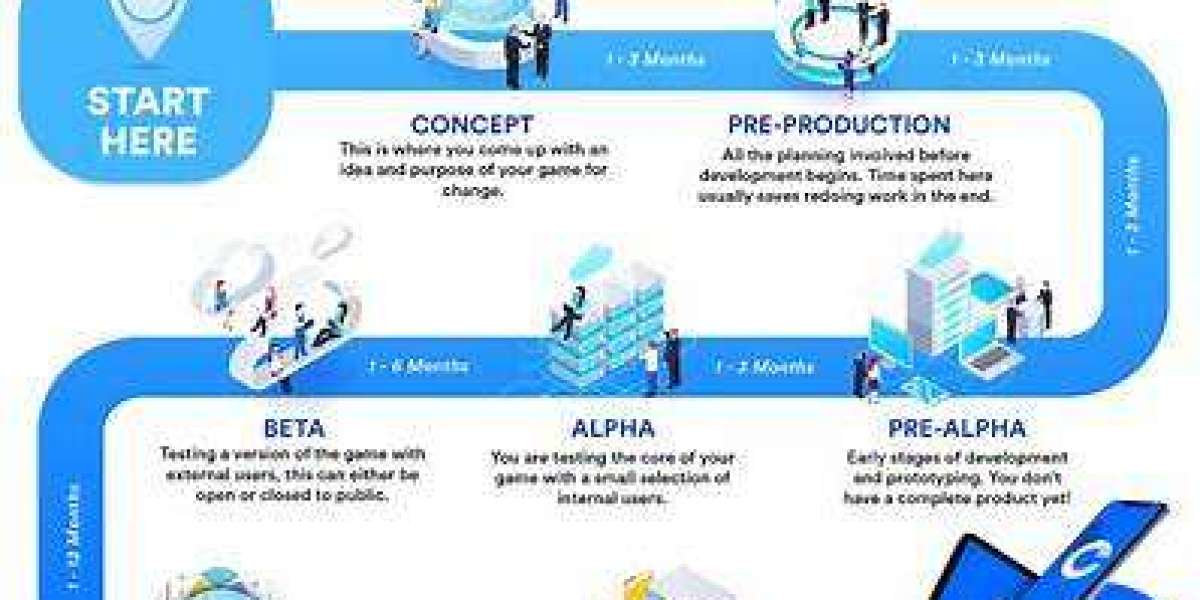It is one of the most dynamic industries in the world, constantly evolving as new technologies, trends, and platforms emerge. From concept development to post-launch support, game development requires the collaboration of various specialists, each bringing their unique expertise to the table.
This article will delve into the essential components of game development, exploring the core stages of the process, the roles involved, the tools used, and the challenges developers face as they bring video games to life. Whether you're an aspiring game developer or simply curious about the inner workings of this creative field, this guide offers valuable insights into the complexities of game development.
Key Stages of Game Development
Game development is typically divided into several stages, each with its specific goals, tasks, and milestones. The process can vary depending on the size of the development team and the scope of the project, but the stages generally include the following:
| Development Stage | Description |
|---|---|
| Conceptualization | The initial phase where the idea for the game is born. It involves brainstorming, defining the core gameplay mechanics, and creating the concept document. |
| Pre-production | Detailed planning and design take place here. This phase includes prototyping, level design, art direction, and creating a roadmap for development. |
| Production | The main development phase where coding, asset creation (art, sound, animation), level design, and writing take place. It is the longest phase in game development. |
| Testing | The game is tested for bugs, gameplay balance, and usability. Quality assurance (QA) teams work to ensure the game runs smoothly. |
| Release | The game is finalized and released to the public. This phase involves final polish, marketing efforts, and distribution. |
| Post-launch | After release, developers work on updates, patches, downloadable content (DLC), and respond to player feedback. |
The Roles Involved in Game Development
Game development requires a variety of skill sets, and multiple roles contribute to the final product. Some roles are more technical, while others are focused on creativity and design. Here are the key roles involved in game development:
| Role | Description |
|---|---|
| Game Designer | Responsible for defining the game mechanics, levels, story, and user experience. They ensure that the game is fun, engaging, and balanced. |
| Programmer | Write the code that makes the game function. Programmers are responsible for the technical aspects of game development, including the game engine, AI, physics, and user interface (UI). |
| Artist | Responsible for creating the visual elements of the game, including character design, environments, textures, and animations. |
| Sound Designer | Create and implement sound effects, voice acting, and background music to enhance the game’s atmosphere and immersion. |
| Writer | Develop the narrative and dialogue for the game. They craft the story, characters, and world-building elements that drive the player’s experience. |
| Quality Assurance (QA) | Test the game for bugs, glitches, and usability issues. QA testers help ensure that the game is stable and free of technical problems before release. |
| Producer | Oversee the development process, manage schedules, budgets, and ensure that the project is delivered on time. They coordinate between departments and manage the team. |
Core Game Development Disciplines
There are several specialized disciplines within game development that each require unique skill sets. These disciplines help shape the different aspects of the game, from its visuals to its gameplay and technical performance.
1. Game Programming
Game programming is one of the most critical aspects of game development. Programmers are responsible for creating the underlying code that makes the game work. They use various programming languages such as C++, C#, Python, and JavaScript to create game engines, AI systems, and gameplay mechanics.
Key Areas of Game Programming:
Game Engines: A game engine is a software platform used to create video games. It provides tools for physics, rendering, animation, and AI. Popular game engines include Unity and Unreal Engine.
Gameplay Programming: Involves coding the game’s mechanics, such as player controls, level logic, and the interactions between objects.
AI Programming: Responsible for creating the behavior of non-player characters (NPCs) and enemies, including pathfinding, decision-making, and combat strategies.
| Game Programming Tools | Description |
|---|---|
| Unity | A versatile game engine that supports 2D and 3D games, often used for mobile and indie game development. |
| Unreal Engine | Known for its high-quality graphics and real-time rendering, widely used in AAA game development. |
| Godot | An open-source game engine that is gaining popularity for its ease of use and flexibility. |
2. Art and Animation
Art and animation play a significant role in shaping the visual experience of a game. Artists are responsible for creating the look and feel of the game world, characters, and environments. This includes 2D art, 3D modeling, textures, lighting, and animation.
Key Areas of Art and Animation:
Concept Art: Concept artists create the visual style and design direction for characters, environments, and assets.
3D Modeling: 3D artists build models of characters, objects, and environments that appear in the game world.
Animation: Animators bring characters and objects to life by creating fluid movements, facial expressions, and actions.
| Art and Animation Tools | Description |
|---|---|
| Blender | An open-source 3D modeling and animation software that is widely used for both indie and professional game development. |
| Maya | A professional 3D animation software used for character modeling, rigging, and animation. |
| Photoshop | Used for creating 2D textures and assets, essential in both 2D and 3D game development. |
3. Sound Design and Music
Sound design and music are integral components of a game’s immersive experience. Sound designers create sound effects for actions, environments, and characters, while composers develop music that enhances the tone and atmosphere of the game.
Key Areas of Sound Design:
Sound Effects: Creating realistic sounds for actions such as footsteps, explosions, and interactions.
Voice Acting: Recording dialogue for characters, which is essential for narrative-driven games.
Music: Composers develop original scores that enhance the mood of the game, from action-packed scenes to serene environments.
| Sound Design Tools | Description |
|---|---|
| Audacity | A free, open-source audio editing software used by many sound designers. |
| Pro Tools | A professional audio editing software used in both music production and sound design for games. |
| FMOD | A sound design tool that integrates with game engines to create interactive soundscapes. |
Emerging Technologies in Game Development
The gaming industry is rapidly embracing new technologies to create more immersive, interactive, and engaging experiences for players. Below are some of the key technologies that are shaping the future of game development:
1. Virtual Reality (VR) and Augmented Reality (AR)
VR and AR technologies are revolutionizing how games are played. VR immerses players in a fully 3D environment, while AR blends digital elements with the real world. As hardware becomes more affordable and accessible, both VR and AR are expected to play a major role in future game development.
2. Artificial Intelligence (AI)
AI is already being used to improve NPC behavior, dynamic storylines, and procedural content generation. In the future, AI will enable more advanced systems for game design, including personalized experiences, where the game adapts to the player’s behavior in real-time.
3. Cloud Gaming
Cloud gaming allows players to stream games directly from the cloud, bypassing the need for high-performance hardware. This trend is expected to grow as internet speeds improve, providing players with access to high-quality games without needing a powerful console or gaming PC.
| Emerging Technologies | Impact on Game Development |
|---|---|
| Virtual Reality | Offers fully immersive experiences where players interact with the game world in real-time. |
| Augmented Reality | Blends the real and virtual worlds, allowing for innovative game mechanics. |
| Artificial Intelligence | Enhances NPC behavior, procedural generation, and dynamic storytelling. |
| Cloud Gaming | Stream games directly from the cloud, eliminating the need for expensive hardware. |
Challenges in Game Development
Game development is a complex process that comes with several challenges. Some of the key difficulties faced by developers include:
Time Constraints: Meeting deadlines can be difficult, especially in large-scale projects, which may result in crunch time and developer burnout.
Budget Limitations: Game development is expensive, and many studios face financial pressure to deliver successful games within budget constraints.
Balancing Innovation with Familiarity: Developers must strike a balance between introducing new gameplay ideas and satisfying player expectations for familiar mechanics.
Conclusion
Game development is an exciting and multi-faceted process that requires collaboration, creativity, and technical expertise. As the industry continues to evolve, developers must stay ahead of new trends, embrace emerging technologies, and work together to create innovative, engaging, and immersive experiences for players. With the continued advancement of AI, VR, AR, and cloud gaming, the future of game development looks promising, offering even more possibilities for the next generation of games.







